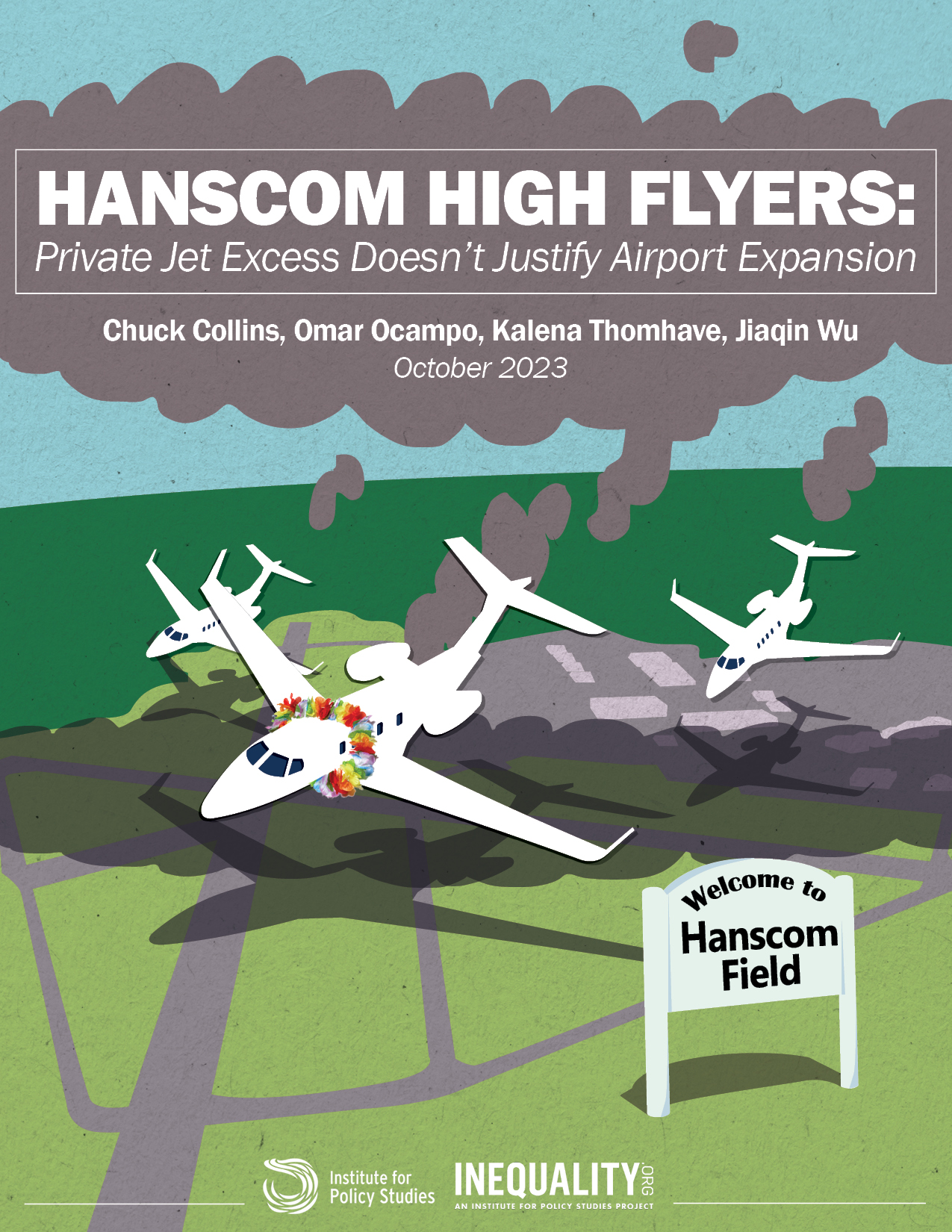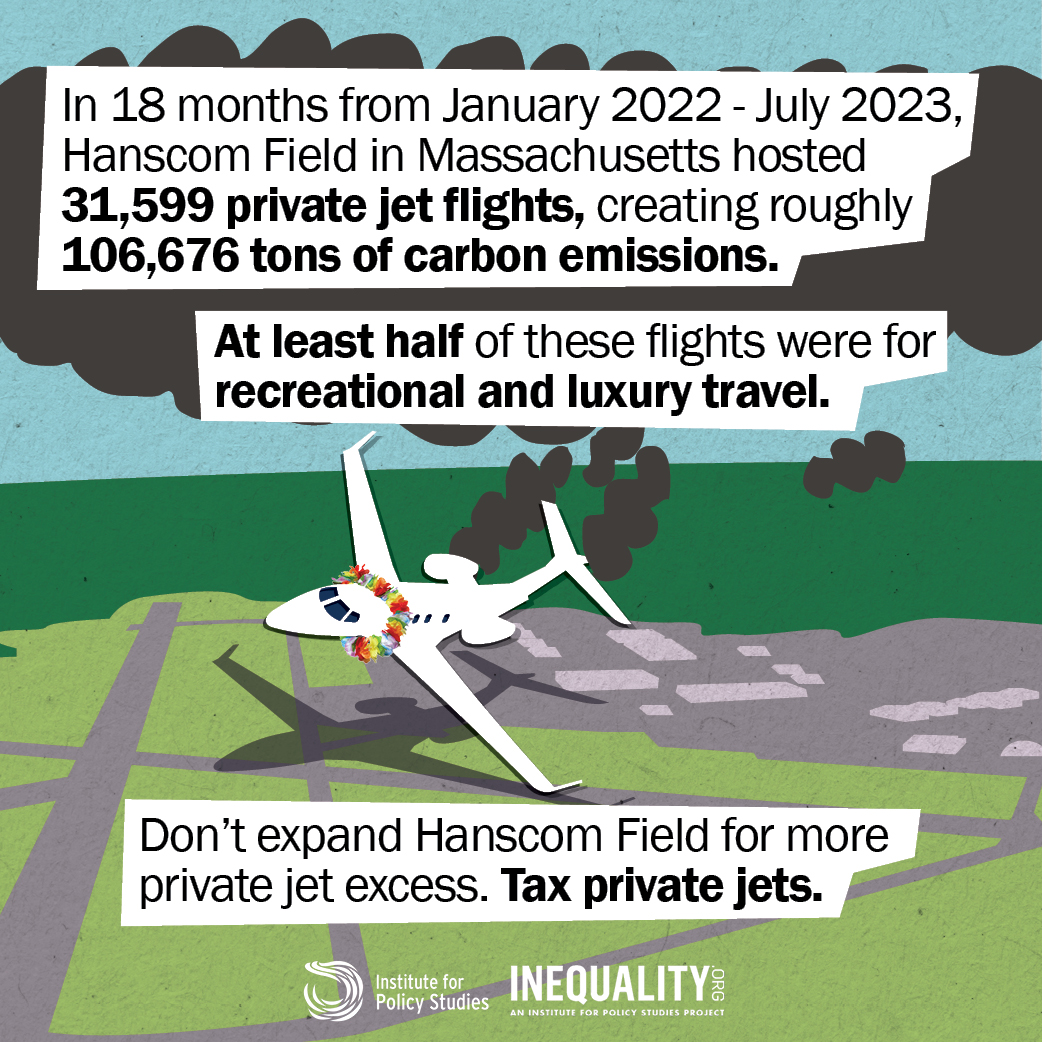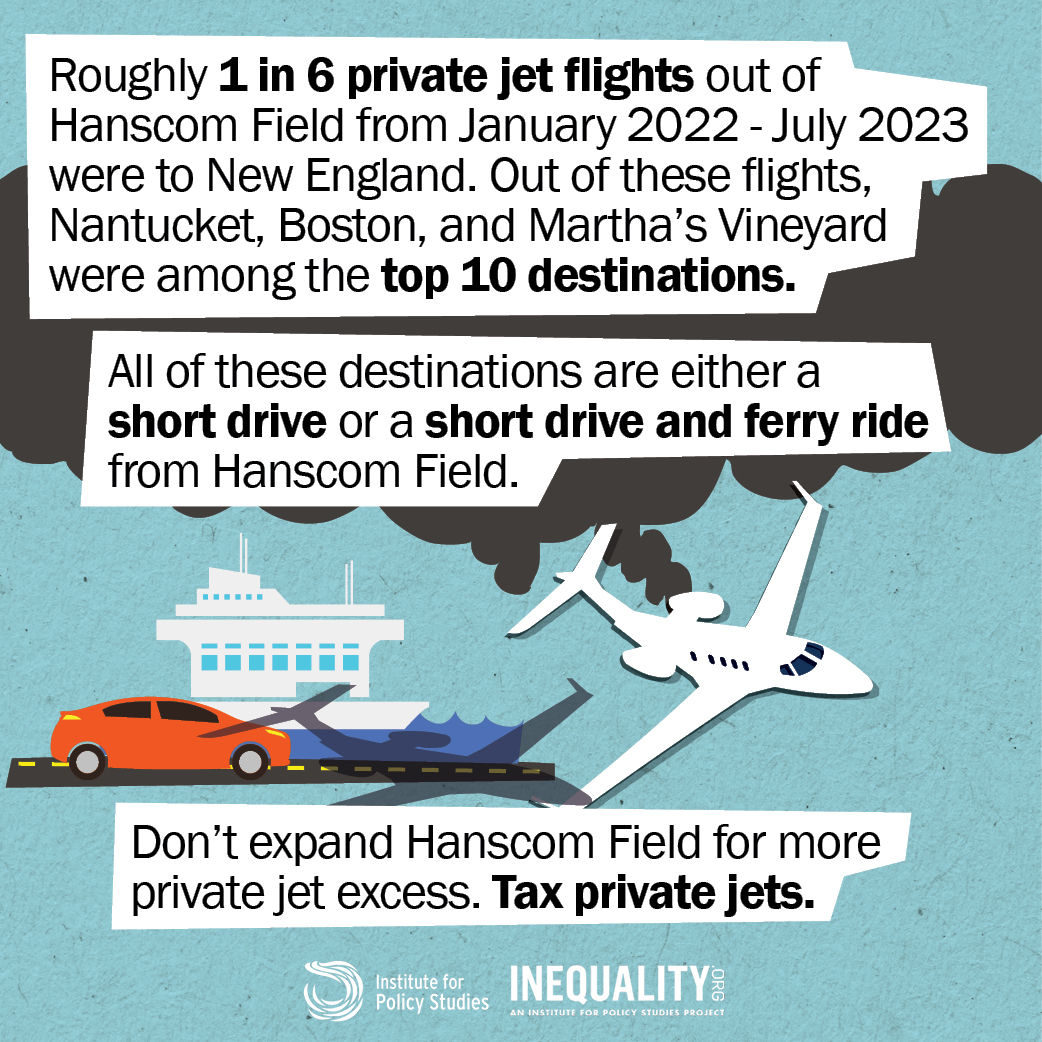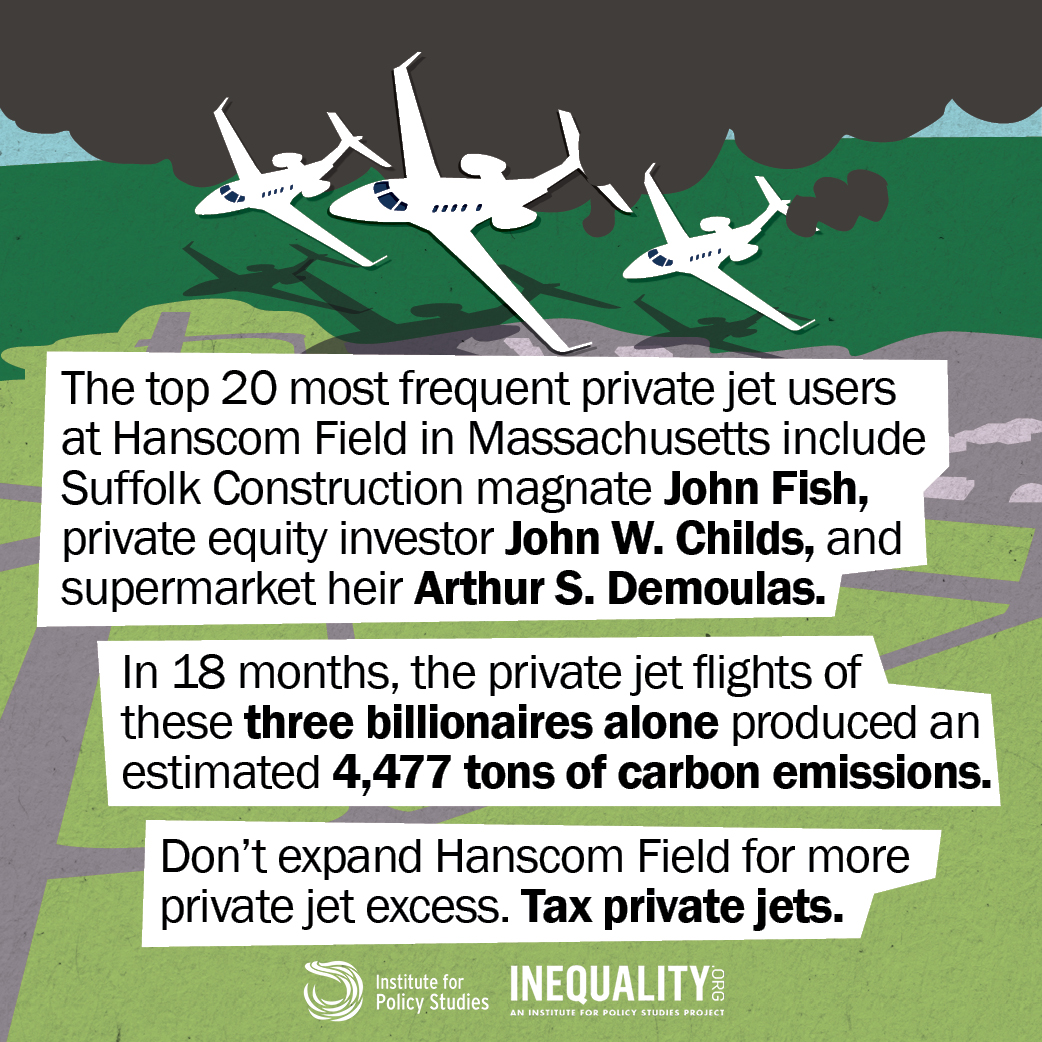Hanscom High Flyers: Private Jet Excess Doesn’t Justify Airport Expansion
Private jet travel is a monumental example of private excess at public expense. Here’s a local case study.
Chuck Collins | Omar Ocampo | Kalena Thomhave| Jiajin Wu
Introduction:
Private jet travel is a monumental example of private excess at public expense.
As we documented in our High Flyers 2023 report earlier this year, private jets pollute 10 to 20 times more per passenger than their commercial counterparts. And although the typical private jet owner is worth nearly $200 million, they pay a far lower share of aircraft fees toward air safety than coach passengers on commercial jets.
In this report, we look at a local example. Laurence G. Hanscom Field, located outside Boston, is New England’s largest general aviation airport and the region’s largest private jet port. Residents there are organizing against a proposed expansion of the airport that would triple its capacity to serve private jets.
We analyzed 18 months worth of data on private flights in and out of Hanscom. We found that wealthy private jet travelers, many of whom frequently take short-hop flights to recreational and luxury destinations from the airfield, would be the primary beneficiaries of the expansion.
Based on these findings, we’re calling for an immediate suspension of private jet service expansions at local airports, more user taxes and fees on private jet travel to fund more sustainable public transit, and greater transparency around private jet flights and their carbon emissions.
A summary of our findings is below. You can read much more in the full version.
Key Findings
- Between January 2022 and July 2023, we identified 31,599 private flights taken by 2,915 jets. Private jets departed Hanscom Field for 761 unique destinations. Over the 18 months studied, private Hanscom Field flights were responsible for an estimated 106,676 tons of carbon emissions.
- We estimate that at least half of these flights (49 percent) were for recreational and luxury travel. This statistic includes the more than 36 percent of flights (5,632 flights) that traveled to 212 airports near luxury or vacation destinations. In addition, more than 42 percent of Hanscom Field flights departed on weekends, also implying recreational travel.
- Roughly 16 percent of private jet flights from Hanscom Field were to destinations in New England. Nantucket, Boston, Martha’s Vineyard, Portland, Portsmouth, Hyannis, and Rockland were among the top 10 flight destinations in New England. All of these destinations are either a short drive or a short drive and ferry ride from Hanscom Field.
- Approximately 41 percent of flights departing Hanscom Field had durations of less than one hour, with 14 percent lasting less than 30 minutes. Because take-off is the most fuel intensive part of a flight, short-hop flights are extremely energy inefficient compared to other transportation alternatives. Yet 81 percent of flights departing from Hanscom Field were in the air less than three hours.
- The private jet flyers on the 20 most active jets at Hanscom Field took 3,240 flights, a number that includes both arrivals and departures. These 20 aircraft accounted for more than 10 percent of all Hanscom Field private jet flights during the 18 months we studied.
- In addition, the 20 frequent flyers were responsible for 14 percent of total carbon emissions, releasing an estimated 14,930 tons of carbon emissions during the study period. For comparison’s sake, the average American produces roughly 14 tons per year in total emissions and the average Massachusetts resident is responsible for nearly 8 tons per year. The global average is 4 tons of carbon emissions per person, per year.
We suspect that this is the tip of the private jet luxury excess iceberg. Private jet owners and operators can request that the FAA exclude their jets from public tracking registries making it impossible for researchers to include this data. Four Boston area billionaires, Robert Kraft, Jim Davis, John Henry and Paul Fireman have all requested their travel data go dark.
Hanscom Field’s “High Flyers”
Hanscom Field’s “High Flyers” — the top 20 private jet travelers using Hanscom Field — are profiled in full in the report. Among these are the following…
John Fish. Belonging to the Suffolk Construction magnate with estimated wealth of $1.2 billion, Fish’s jet was the number three most frequent flyer out of Hanscom Field, but the number one carbon emitter over 18 months, releasing an estimated 2,329 tons of carbon emissions on flights that included 44 round trip flights to West Palm Beach and flights to Aruba; Aspen, Colorado; and Barcelona, Spain.
John W. Childs. The jet owned by private equity investor John Childs was the fifth most frequent flyer out of Hanscom Field but the third largest carbon emitter, releasing an estimated 1,407 tons of carbon over the study period. Child’s jet makes frequent trips to Vero Beach, Florida, where Child owns a home, and Rosario, Argentina, where he is part owner of a bird hunting lodge. In the last eighteen months, the jet has also traveled to Palermo, Italy; the U.S. Virgin Islands; Palm Springs, California; and the Hamptons.
Arthur S. Demoulas. Arthur S. Demoulas, with wealth estimated at $1.3 billion, is famous for his unsuccessful attempt to oust his cousin, Arthur T. Demoulas, from the leadership of New England supermarket chain Market Basket. The private jet registered in Arthur S.’s name was the 10th most frequent Hanscom Field flyer, with flights to Aspen, Key West, and London. Total estimated carbon emissions were 741 tons.
Owners Affiliated with Private Equity Firms. Seven of the top 20 Hanscom Field flyers are jets owned or connected to personnel at private equity firms based in the Boston area. These include powerful and influential firms such as J.W. Childs, Panther Residential Management, Thomas H Lee Partners, L.P. and Charlesbank Partners. Top executives based at these private equity firms own these jets through trusts and shell companies. Together, the seven jets took 1,244 flights and emitted an estimated 2,899 tons of carbon over the study period.
Recommendations
Greater Ownership Transparency. There is no absolute right to privacy in using our publicly-funded air traffic control system. The public has a right to who owns the aircraft flying over our communities and consuming public services (and pressing for expansion). Wealthy high-flyers should not have the ability to “opt out” of public data registries, just as car owners shouldn’t be able to hide their car license plates. This may require modifying the rules governing the FAA’s Limiting Aircraft data Displayed (LADD) Program.
Stop Private Jet Expansion at Hanscom and Everywhere. We recommend that Massport and other state and local agencies reject the expansion of Hanscom Field and any future plans at Logan Field for increased private jet capacity.
Eliminate the Massachusetts Aviation Sales Tax Exemption. The private jet lobby and the aviation industry have lobbied to protect this sales tax exemption. If we tax bicycle and automobile sales, we should tax plane sales.
Increase Excise Tax on Jet Fuel and Invest in Green Transit. To reduce carbon emissions in the aviation sector, federal lawmakers should steeply tax private jet travel and direct those funds toward climate mitigation and green infrastructure. Legislation introduced by U.S. Senator Ed Markey (D-MA), the Fueling Alternative Transportation with a Carbon Aviation Tax Act of 2023, would do precisely this. It would increase the excise tax on jet fuel from 22 cents per gallon to $1.95, effectively adding $200 per ton of carbon emitted. Markey’s plan to increase the excise tax on private jet fuel would generate more than $1.8 billion annually for transit alternatives.
More national recommendations are available in our High Flyers 2023 report.





